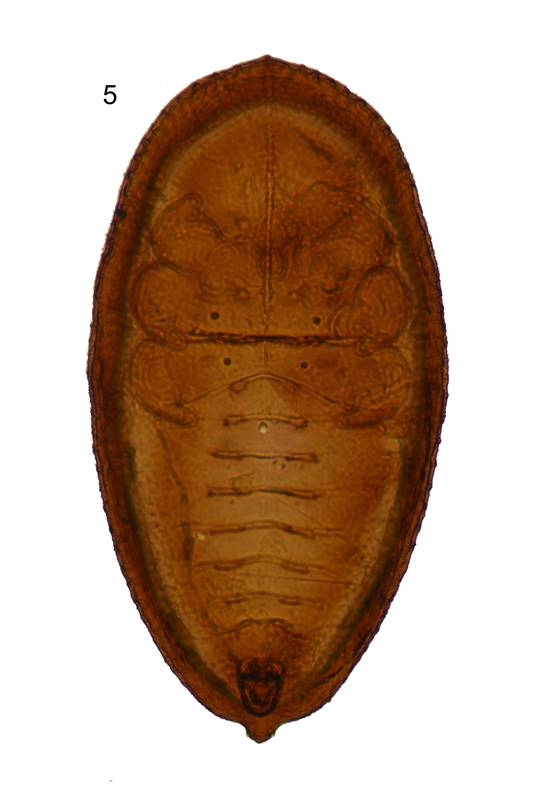INTRODUCTION
Drews and Sampson (1956) described the genus Aleuropleurocelus for its type species, Aleuropleurocelus laingi (Drews & Sampson, 1956). Other species in the genus which also have boat-shaped puparia include: Aleuropleurocelus coachellensis Drews and Sampson, A. ornatus Drews and Sampson, A. ceanothi Sampson (1945), A. sierrae Sampson (1945), A. oblanceolatusDrews and Sampson (1958), in addition, they transferred Aleuropleurocelus nigrans (Bemis), a species known to occur in California and Mexico, from the genus Aleyrodes Latreille and Martin (2005) transfered Aleuropleurocelus cecropiae Bondar, a brazilian species from the genus Aleurotrachelus. Dooley et al. (2010) described Aleuropleurocelus nevadensis Dooley from Nevada, Polaszek and Gill (2011) described Aleuropleurocelus hyptisemoryi Gill from California. From Mexico Carapia-Ruiz et al. (2018); Sánchez-Flores et al. 2018a; 2018b described Aleuropleurocelus anahuac Carapia & Sánchez, Aleuropleurocelus mexicanus Carapia & Sánchez, Aleuropleurocelus guerrerensis Carapia & Sánchez and Aleuropleurocelus xalapensisSánchez-Flores & Carapia-Ruiz, 2018. Martin (2005) listed 10 undescribed species of the genus Aleuropleurocelus and their hosts occurring in Belize. An examination of specimens from the Collections of the Escuela de Estudios Superiores de Xalostoc (EESuX) of the Universidad Autónoma del Estado de Morelos (UAEM) and recent collections in the states of Oaxaca and Guerrero, indicate that the presence of two new Aleuropleurocelus species which are described and illustrated here.
MATERIALS AND METHODS
Specimens were collected from the underside of Coccoloba uvifera leaves in Asuncion Ixtaltepec, State of Oaxaca, and from the underside of Diospyros acapulcensis subsp. acapulcensis leaves in Acapulco, State of Guerrero. They were transferred to the taxonomic laboratory for insects and mites in the Departamento de Parasitología Agrícola (DPA) de la Universidad Autónoma Agraria Antonio Narro (UAAAN), where they were mounted on slides for examination under the compound microscope. The protocols by Martin (2004), with some modifications, were followed for the preparation of slides. All measurements are given in microns (μm).
Observations and measurements of structures. Mounted specimens were examined under a compound microscope, Motic BA 310 equipped with a micrometer and camera to take images at 40, 100, 400 and 1000x.
Type depositories. CNIN-Colección Nacional de Insectos, Instituto de Biología, Universidad Nacional Autónoma de México, Ciudad de México. BMNH-The Natural History Museum, London SW7 5BD, UK. OASF-Personal collection of Oscar Angel Sanchez-Flores. VECR-Personal collection of Vicente Emilio Carapia-Ruiz.
Taxonomy
Aleuropleurocelus Drews & Sampson
Distribution. New World.
Diagnosis. Puparia almost always black, shape usually elongate, boat-like or oval in shape. Margin deflexed. Dorsum. Inner margin of vasiform orifice smooth or dentate; lingula usually obscured; operculum covers 50% of the vasiform orifice. Puparia usually covered with granules or imbrications most, but not all, posterior area pointed with an apical (caudal) pair of setae (Drews & Sampson, 1958).
Similar genera. Puparia of the genus Aleuropleurocelus are similar to the genus Tetralicia Harrison (1917). Drews & Sampson (1956) distinguished it from Tetralicia by the vasiform orifice which has a smooth inner margin with the operculum filling or nearly filling the orifice whereas the inner margin of the vasiform orifice of Tetralicia has teeth and the operculum fills three-fourths or less of the orifice. Geographically, Aleuropleurocelus is known from the Western Hemisphere whereas Tetralicia is primarily known from the Palaearctic region.
Note: Since the puparia are very dark, they need to be bleached before mounting on slides.
Aleuropleurocelus caudatus Sánchez-Flores and Carapia-Ruiz sp. nov.
Puparium. Black and boat-shaped; 650 μm long and 340 μm wide (Figs. 1,5). Convex lateral margin; deflected external margin with imbricated marginal band (Fig. 8).
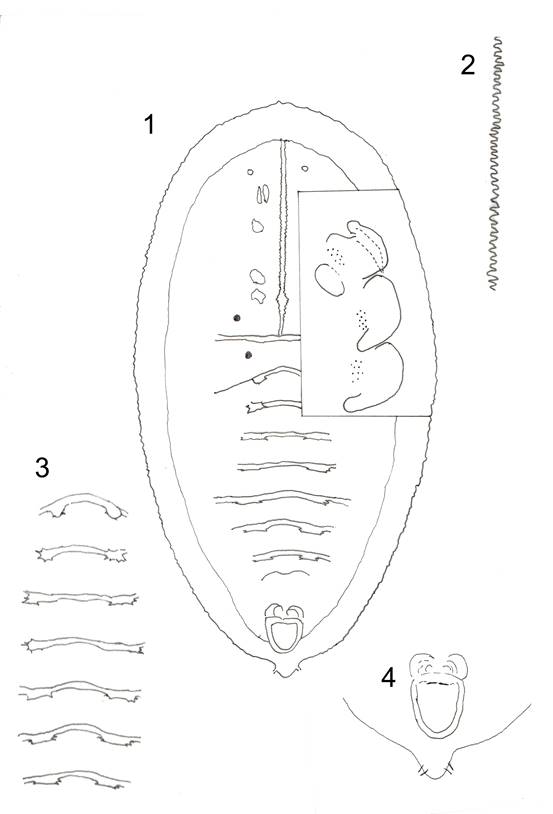
Figures 1-4 Aleuropleurocelus caudatus Sánchez-Flores & Carapia-Ruiz sp. nov. 1, puparium; 2, marginal teeth; 3, submedian abdominal depression on each of segments I-VII; 4, vasiform orifice.
Cephalothorax. Eyes absent; four longitudinally divided anterior structures near the submarginal fold present; cephalic setae absent. Mesothoracic and metathoracic setae present. Longitudinal suture 320 μm long with a single row of granules on each side (zipper-like) extending from the transverse suture toward the anterior margin (Fig. 6); transverse molting suture ending before reaching the apparent margin.
Abdomen. (Figs. 3,7). Abdominal segments A1-A8 clearly visible in the central region with an approximate length (μm) along the midline of each of: A1 37.5, A2 40, A3 35, A4 32.5, A5 32.5, A6 35, A7 27.5 and A8 15. Abdominal depressions present on segments A1-A7 with the following length/width dimensions (μm): A1 12/12, A2 15/15, A3 15/35, A4 15/45, A5 15/40, A6 15/15 and A7 12/15. Mid-section of abdominal segments smooth.
Vasiform orifice. (Figs. 4,9). Semi-square, 42.5 μm long and 37.5 μm wide. Operculum 27.5 μm long and 25 μm wide, covering the lingula and most of the vasiform orifice. Distance from vasiform orifice to caudal setae 28 μm. Caudal protuberance present.
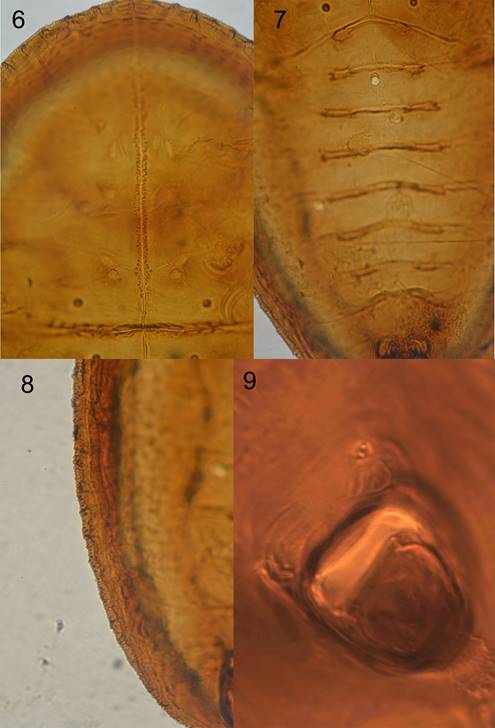
Figures 6-9 Aleuropleurocelus caudatus Sánchez-Flores & Carapia-Ruiz sp. nov. 6, transverse moltingsuture; 7, submedia abdominal depressions; 8, apparent lateral margin; 9, vasiform orifice.
Venter. Antennae extending to prothoracic legs; 75 μm long, 50 μm wide. Ventrally with an irregular broad band of spines on which area. Thoracic cuticle apparently smooth, a pair of adhesive pads present near the base of the first pair of legs. Abdominal cuticle smooth.
Chaetotaxy. Anterior and Posterior marginal setae absent, first abdominal absent, cephalic setae absent. One pair of setae each on mesothorax and metathorax and one pair of small setae (4-6 μm) on abdominal segment VIII, which arises from a tubercular area anterior to the margin of the vasiform orifice (Fig. 9). Caudal setae present, 28 μm of long.
Type Material. Holotype puparium: México: Oaxaca, Asuncion Ixtaltepec, El morrito., 219 masl [meters above sea level], 16° 43' 26.9" N, 94° 58' 54" W, 21-Jun-2017, coll. Oscar Angel Sanchez-Flores, ex: underside of leaves Coccoloba uvifera (Deposited in CNIN).
Paratypes: 12 puparia, same data as holotype (NHM 1 puparium; OSSF 6 puparia; VECR 5 puparia)
Etymology. Named for the prominent feature on the caudal end of puparium.
Distribution. México: States of Oaxaca (Asuncion Ixtaltepec, Pochutla).
Hosts. Coccoloba uvifera (Polygonaceae) common name: seagrape,baygrape; and Guazuma ulmifolia (Malvaceae), common name: copal, West Indian elm, bay cedar.
Remarks. The puparium of Aleuropleurocelus caudatus Sánchez-Flores and Carapia-Ruiz sp. nov. resembles that of A. nigrans (Bemis) but differs by having the caudal end more pronounced (sinuosed) and longer; zipper ornamentation along the longitudinal molting suture; wider abdominal depressions (not good characters for diagnosis); and a longer semi-square vasiform orifice. It differs from Aleuropleurocelus ceanothi (Sampson) by the transverse molting suture not reaching the apparent lateral margin.
Aleuropleurocelus bidentatus Sánchez-Flores and Carapia-Ruiz sp. nov.
Puparium. Black and boat-shaped. Found on the underside of the leaves of its host; 650 μm long, 340 μm wide (Figs. 10,14). Convex lateral margin; deflected external margin with imbricated marginal band. True margin with double row of teeth, one directed towards outer part of pupa and the other directed towards inner part of pupa (Figs. 11,15).
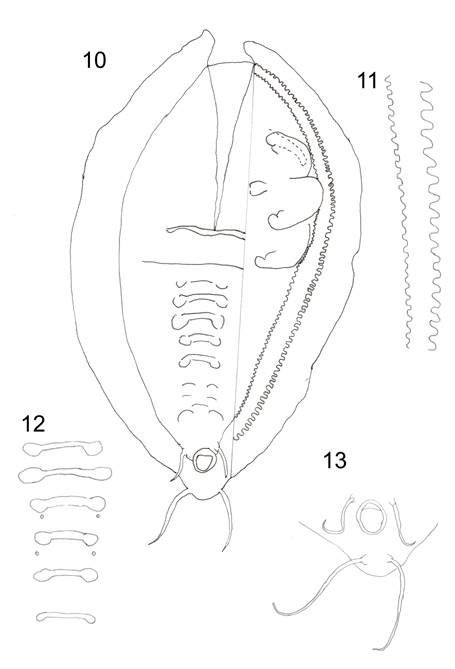
Figures 10-13 Aleuropleurocelus bidentatus Sánchez-Flores & Carapia-Ruiz sp. nov., 10, puparium; 11, marginal teeth; 12, submedian abdominal depression on segments I-VI; 13, vasiform orifice.
Cephalothorax. Eyes absent, four longitudinally divided anterior structures present near the submarginal fold of the anterior cephalic section, cephalic setae present. Medial area of thorax with a pair of setae on each mesothorax and metathorax segment. Longitudinal suture 310 μm long; transversal molting 290 μm long, ending before reaching the apparent margin.
Abdomen. (Fig. 12, 16). Abdominal segments A1-A8 clearly visible in the central region with approximate length (μm) along the midline of each: A1 22, A2 26, A323, A4 31, A5 34, A6 27, A7 21, and A8 18. Abdominal depressions present in the segments A1-A6 with the following length/width (μm) dimensions: A1: 9.2/12.6, A2: 11.5/20, A3: 12.5/16.5, A4:10.4 14, A5: 8.2/8.2, and A6: 8/9.
Vasiform orifice. (Fig. 13). Semiovoid, 33 μm long and 28 μm wide. Operculum 24 μm long and 33 μm wide, covering the lingula and most of the vasiform orifice. Distance from vasiform orifice to apparent margin 48 μm. Caudal protuberance present.
Venter. Antennae 70 μm long, extending to prothoracic legs; legs and most thoracic cuticle covered with spines (Fig. 18). Abdominal cuticle apparently smooth.
Chaetotaxy. Cephalic setae absent. One pair of setae on each mesothorax and metathorax segment, and a pair on abdominal segment VIII, each arising from a tubercular base along the anterior-lateral margin of the vasiform orifice. Caudal setae 254 μm long.
Type Material. Holotype: México: Guerrero, Acapulco, 2 masl [meters above sea level], 16° 49' 30.6" N, 99° 51'43. 7" W, 23-Jul-2017, coll. Vicente Emilio Carapia-Ruiz, on the underside of leaves of Diospyros acapulcensis subsp. acapulcensis (CNIN).
Paratypes: 42, same data as holotype (NHM 1 puparium; OSSF 21 puparia; VECR 20 puparia).
Etymology. Named for the double row of teeth at the margin.
Distribution. México: State of Guerrero (Acapulco).
Host. Diospyros acapulcensis subsp. acapulcensis (Ebenaceae).
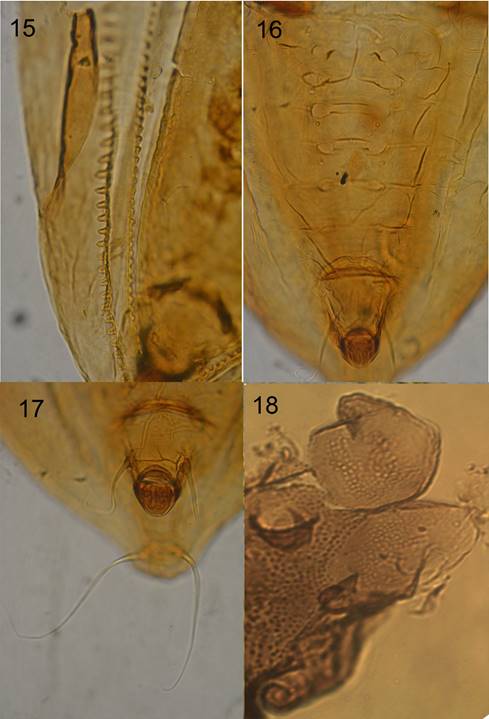
Figures 15-18 Aleuropleurocelus bidentatus Sánchez-Flores & Carapia-Ruiz sp. nov. 15, marginal teeth; 16, submedian abdominal; 17, vasiform orifice; 18, legs.
Remarks. This species is smaller than all the other known Mexican species in the genus Aleuropleurocelus and is the only species with a double row of teeth along the true lateral margin.











 nueva página del texto (beta)
nueva página del texto (beta)

